How Well Can IMERG Products Capture Typhoon Extreme Precipitation Events over Southern China?
Abstract
1. Introduction
2. Study Region, Data and Method
2.1. Study Region
2.2. Data
2.3. Statistics Metrics
3. Results
3.1. Spatial Analysis
3.2. Hourly-Series Rainfall
3.3. Probability Distribution by Occurrence
3.4. Analysis of Bias
3.5. Contingency Analysis
3.6. Analysis of Agreement and Disagreement Statistics
4. Summary and Conclusions
- (1).
- IMERG products, either the Early Run or the Final Run, generally capture the spatiotemporal variability of precipitation with moderate to high CCs (0.6 to 0.87) for most of events except Mawar in which IMERG_ERUncal has low CC about 0.49 (Figure 2), and with RB ranging from −15.27% to 42.55%, and RMSE ranging from 31.58 mm to 47.50 mm (Figure 1).
- (2).
- Overall, the IMERG products track reasonably well the temporal variation of the area-average hourly precipitation over Guangdong (with high CCs from 0.78 to 0.93) and rainfall centers (with high CCs from 0.74 to 0.94) during six typhoon-related events. All IMERG products tend to overestimate the peak rainfall especially IMERG_ERUncal overestimates the most. IMERG_FRUncal overestimated less than IMERG_ERUncal. IMERG_FRCal shows best agreement with gauge observations (Figure 7 and Figure 8).
- (3).
- All IMERG products underestimate the light precipitation (<0.6 mm/h) and overestimate the light to moderate precipitation in 0.6–6 mm/h (Figure 9).
- (4).
- The FB is the primary component that contributes most to the total bias during all events. IMERG_FRCal tends to have negative HB, and both IMERG_FRCal and IMERG_FRUncal are inclined to have larger magnitude of HB than IMERG_FRCal does.
- (5).
- IMERG_FRUncal and IMERG_FRCal have the same capability of detecting rainy events, showing higher POD and CSI, and lower FAR than IMERG_ERUncal. IMERG_FRUncal and IMERG_FRCal have higher POD and CSI than IMERG_ERUncal when rain rates are less than 10 mm/h. IMERG_ERUncal and IMERG_FRUncal demonstrate higher POD and CSI than IMERG_FRCal when rain rates are greater than 10 mm/h (Figure 13).
- (6).
- The large magnitude of underestimation and overestimation of the heavy rainfall regions by satellite-only IMERG is primarily linked to the lack of microwave sensor observations. The limitations of IR-based and PMW-based rainfall estimation over complex terrains are attributed to the large bias of IMERG products when compared to gauge observations.
Author Contributions
Funding
Conflicts of Interest
References
- Fischer, E.M.; Knutti, R. Anthropogenic contribution to global occurrence of heavy-precipitation and high-temperature extremes. Nat. Clim. Chang. 2015, 5, 560. [Google Scholar] [CrossRef]
- Rahmstorf, S.; Coumou, D. Increase of extreme events in a warming world. Proc. Natl. Acad. Sci. USA 2011, 108, 17905–17909. [Google Scholar] [CrossRef] [PubMed]
- Duffy, P.; Tebaldi, C. Increasing prevalence of extreme summer temperatures in the US. Clim. Chang. 2012, 111, 487–495. [Google Scholar] [CrossRef]
- Kunkel, K.E.; Karl, T.R.; Brooks, H.; Kossin, J.; Lawrimore, J.H.; Arndt, D.; Bosart, L.; Changnon, D.; Cutter, S.L.; Doesken, N. Monitoring and understanding trends in extreme storms: State of knowledge. Bull. Am. Meteorol. Soc. 2013, 94, 499–514. [Google Scholar] [CrossRef]
- Rudeva, I.; Gulev, S.K. Climatology of Cyclone Size Characteristics and Their Changes during the Cyclone Life Cycle. Mon. Weather Rev. 2007, 135, 2568–2587. [Google Scholar] [CrossRef]
- Clifton, H.E. Sedimentologic relevance of convulsive geologic events. Geol. Soc. Am. Abstr. Progr. 1985, 17, 1–6. [Google Scholar]
- Sorooshian, S.; Hsu, K.L.; Gao, X.; Gupta, H.V.; Imam, B.; Braithwaite, D. Evaluation of PERSIANN system satellite-based estimates of tropical rainfall. Bull. Am. Meteorol. Soc. 2000, 81, 2035–2046. [Google Scholar] [CrossRef]
- Hong, Y.; Hsu, K.L.; Sorooshian, S.; Gao, X. Precipitation estimation from remotely sensed imagery using an artificial neural network cloud classification system. J. Appl. Meteorol. 2004, 43, 1834–1853. [Google Scholar] [CrossRef]
- Joyce, R.J.; Janowiak, J.E.; Arkin, P.A.; Xie, P. CMORPH: A method that produces global precipitation estimates from passive microwave and infrared data at high spatial and temporal resolution. J. Hydrometeorol. 2004, 5, 487–503. [Google Scholar] [CrossRef]
- Huffman, G.J.; Bolvin, D.T.; Nelkin, E.J.; Adler, R.F. Highlights of Version 7 TRMM Multi-satellite Precipitation Analysis (TMPA). In Proceedings of the 5th International Precipitation Working Group Workshop, Workshop Program and Proceedings, Hamburg, Germany, 11–15 October 2010; Klepp, C., Huffman, G., Eds.; Reports on Earth Sys. Sci. 100/2011. Max-Planck-Institut für Meteorologie: Hamburg, Germany, 2011; pp. 109–110, ISSN 1614-1199. [Google Scholar]
- Huffman, G.J.; Bolvin, D.T.; Nelkin, E.J.; Wolff, D.B.; Adler, R.F.; Gu, G.; Hong, Y.; Bowman, K.P.; Stocker, E.F. The TRMM multisatellite precipitation analysis (TMPA): Quasi-global, multiyear, combined-sensor precipitation estimates at fine scales. J. Hydrometeorol. 2007, 8, 38–55. [Google Scholar] [CrossRef]
- Kubota, T.; Shige, S.; Hashizume, H.; Aonashi, K.; Takahashi, N.; Seto, S.; Takayabu, Y.N.; Ushio, T.; Nakagawa, K.; Iwanami, K. Global precipitation map using satellite-borne microwave radiometers by the GSMaP Project: Production and validation. IEEE Trans. Geosci. Remote Sens. 2007, 45, 2259–2275. [Google Scholar] [CrossRef]
- Aonashi, K.; Awaka, J.; Hirose, M.; Kozu, T.; Kubota, T.; Liu, G.; Shige, S.; Kida, S.; Seto, S.; Takahashi, N. GSMaP passive microwave precipitation retrieval algorithm: Algorithm description and validation. J. Meteorol. Soc. Jpn. 2009, 87, 119–136. [Google Scholar] [CrossRef]
- Ushio, T.; Sasashige, K.; Kubota, T.; Shige, S.; Okamota, K.; Aonashi, K.; Inoue, T.; Takahashi, N.; Iguchi, T.; Kachi, M. A Kalman Filter Approach to the Global Satellite Mapping of Precipitation (GSMaP) from Combined Passive Microwave and Infrared Radiometric Data. J. Meterorol. Soc. Jpn. Ser. II 2009, 87, 137–151. [Google Scholar] [CrossRef]
- Shige, S.; Yamada, T.; Tsukiyama, T.; Kida, S. The GSMaP precipitation retrieval algorithm for microwave sounders. Part I: Over-ocean algorithm. IEEE Trans. Geosci. Remote Sens. 2009, 47, 5. [Google Scholar] [CrossRef]
- Chen, S.; Hu, J.; Zhang, Z.; Behrangi, A.; Hong, Y.; Gebregiorgis, A.S.; Cao, J.; Hu, B.; Xue, X.; Zhang, X. Hydrologic Evaluation of the TRMM Multisatellite Precipitation Analysis Over Ganjiang Basin in Humid Southeastern China. IEEE J. Sel. Top. Appl. Earth Obs. Remote Sens. 2015, 8, 4568–4580. [Google Scholar] [CrossRef]
- Chen, S.; Hong, Y.; Cao, Q.; Kirstetter, P.-E.; Gourley, J.J.; Qi, Y.; Zhang, J.; Howard, K.; Hu, J.; Wang, J. Performance evaluation of radar and satellite rainfalls for Typhoon Morakot over Taiwan: Are remote-sensing products ready for gauge denial scenario of extreme events? J. Hydrol. 2013, 506, 4–13. [Google Scholar] [CrossRef]
- Chen, Y.; Ebert, E.E.; Walsh, K.J.; Davidson, N.E. Evaluation of TRMM 3B42 precipitation estimates of tropical cyclone rainfall using PACRAIN data. J. Geophys. Res. Atmos. 2013. [Google Scholar] [CrossRef]
- Shen, Y.; Zhao, P.; Pan, Y.; Yu, J. A high spatiotemporal gauge-satellite merged precipitation analysis over China. J. Geophys. Res. Atmos. 2014, 119. [Google Scholar] [CrossRef]
- Jiang, H.; Zipser, E.J. Contribution of tropical cyclones to the global precipitation from eight seasons of TRMM data: Regional, seasonal, and interannual variations. J. Clim. 2010, 23, 1526–1543. [Google Scholar] [CrossRef]
- Gourley, J.J.; Hong, Y.; Flamig, Z.L.; Wang, J.; Vergara, H.; Anagnostou, E.N. Hydrologic Evaluation of Rainfall Estimates from Radar, Satellite, Gauge, and Combinations on Ft. Cobb Basin, Oklahoma. J. Hydrometeorol. 2011, 12, 973–988. [Google Scholar] [CrossRef]
- Ruin, I.; Lutoff, C.; Creton-Cazanave, L.; Anquetin, S.; Borga, M.; Chardonnel, S.; Creutin, J.; Gourley, J.; Gruntfest, E.; Nobert, S. Toward a Space-Time Framework for Integrated Water and Society Studies. Bull. Am. Meteorol. Soc. 2012. [Google Scholar] [CrossRef]
- Hou, A.Y.; Kakar, R.K.; Neeck, S.; Azarbarzin, A.A.; Kummerow, C.D.; Kojima, M.; Oki, R.; Nakamura, K.; Iguchi, T. The global precipitation measurement mission. Bull. Am. Meteorol. Soc. 2014, 95, 701–722. [Google Scholar] [CrossRef]
- Chen, S.; Liu, H.; You, Y.; Mullens, E.; Hu, J.; Yuan, Y.; Huang, M.; He, L.; Luo, Y.; Zeng, X. Evaluation of High-Resolution Precipitation Estimates from Satellites during July 2012 Beijing Flood Event Using Dense Rain Gauge Observations. PLoS ONE 2014, 9, e89681. [Google Scholar] [CrossRef] [PubMed]
- Huang, Y.; Chen, S.; Cao, Q.; Hong, Y.; Wu, B.; Huang, M.; Qiao, L.; Zhang, Z.; Li, Z.; Li, W. Evaluation of Version-7 TRMM Multi-Satellite Precipitation Analysis Product during the Beijing Extreme Heavy Rainfall Event of 21 July 2012. Water 2013, 6, 32–44. [Google Scholar] [CrossRef]
- Chen, S.; Hu, J.; Zhang, A.; Min, C.; Huang, C.; Liang, Z. Performance of near real-time Global Satellite Mapping of Precipitation estimates during heavy precipitation events over northern China. Theor. Appl. Climatol. 2018, 1–15. [Google Scholar] [CrossRef]
- Habib, E.; Henschke, A.; Adler, R.F. Evaluation of TMPA satellite-based research and real-time rainfall estimates during six tropical-related heavy rainfall events over Louisiana, USA. Atmos. Res. 2009, 94, 373–388. [Google Scholar] [CrossRef]
- Guo, H.; Chen, S.; Bao, A.; Behrangi, A.; Hong, Y.; Ndayisaba, F.; Hu, J.; Stepanian, P.M. Early assessment of Integrated Multi-satellite Retrievals for Global Precipitation Measurement over China. Atmos. Res. 2016, s176–s177, 121–133. [Google Scholar] [CrossRef]
- Zhao, H.; Yang, S.; You, S.; Huang, Y.; Wang, Q.; Zhou, Q. Comprehensive Evaluation of Two Successive V3 and V4 IMERG Final Run Precipitation Products over Mainland China. Remote Sens. 2017, 10, 34. [Google Scholar] [CrossRef]
- Ning, S.; Wang, J.; Jin, J.; Ishidaira, H. Assessment of the Latest GPM-Era High-Resolution Satellite Precipitation Products by Comparison with Observation Gauge Data over the Chinese Mainland. Water 2016, 8, 481. [Google Scholar] [CrossRef]
- Ning, S.; Song, F.; Udmale, P.; Jin, J.; Thapa, B.R.; Ishidaira, H. Error Analysis and Evaluation of the Latest GSMap and IMERG Precipitation Products over Eastern China. Adv. Meteorol. 2017, 2017, 1–16. [Google Scholar] [CrossRef]
- Tang, G.; Ma, Y.; Long, D.; Zhong, L.; Hong, Y. Evaluation of GPM Day-1 IMERG and TMPA Version-7 legacy products over Mainland China at multiple spatiotemporal scales. J. Hydrol. 2016, 533, 152–167. [Google Scholar] [CrossRef]
- Sahlu, D.; Nikolopoulos, E.I.; Moges, S.A.; Anagnostou, E.N.; Hailu, D. First Evaluation of the Day-1 IMERG over the Upper Blue Nile Basin. J. Hydrometeorol. 2016, 17, 2875–2882. [Google Scholar] [CrossRef]
- Chen, F.; Li, X. Evaluation of IMERG and TRMM 3B43 monthly precipitation products over mainland China. Remote Sens. 2016, 8, 472. [Google Scholar] [CrossRef]
- Oliveira, R.; Maggioni, V.; Vila, D.; Morales, C. Characteristics and diurnal cycle of GPM rainfall estimates over the central Amazon region. Remote Sens. 2016, 8, 544. [Google Scholar] [CrossRef]
- Oliveira, R.; Maggioni, V.; Vila, D.; Porcacchia, L. Using Satellite Error Modeling to Improve GPM-Level 3 Rainfall Estimates over the Central Amazon Region. Remote Sens. 2018, 10, 336. [Google Scholar] [CrossRef]
- Omranian, E.; Sharif, H.O. Evaluation of the Global Precipitation Measurement (GPM) Satellite Rainfall Products over the Lower Colorado River Basin, Texas. J. Am. Water Resour. Assoc. 2018, 54, 882–898. [Google Scholar] [CrossRef]
- Omranian, E.; Sharif, H.; Tavakoly, A. How well can global precipitation measurement (GPM) capture hurricanes? case study: Hurricane Harvey. Remote Sens. 2018, 10, 1150. [Google Scholar] [CrossRef]
- Wang, C.; Tang, G.; Han, Z.; Guo, X.; Hong, Y. Global intercomparison and regional evaluation of GPM IMERG Version-03, Version-04 and its latest Version-05 precipitation products: Similarity, difference and improvements. J. Hydrol. 2018, 564, 342–356. [Google Scholar] [CrossRef]
- Zhang, A.; Xiao, L.; Min, C.; Chen, S.; Kulie, M.; Huang, C.; Liang, Z. Evaluation of latest GPM-Era high-resolution satellite precipitation products during the May 2017 Guangdong extreme rainfall event. Atmos. Res. 2019, 216, 76–85. [Google Scholar] [CrossRef]
- Khan, S.; Maggioni, V.; Kirstetter, P.E. Investigating the Potential of Using Satellite-Based Precipitation Radars as Reference for Evaluating Multisatellite Merged Products. J. Geophys. Res. Atmos. 2018, 123, 8646–8660. [Google Scholar] [CrossRef]
- Elliott, R.J.R.; Strobl, E.; Sun, P. The local impact of typhoons on economic activity in China: A view from outer space. J. Urban Econ. 2015, 88, 50–66. [Google Scholar] [CrossRef]
- Wu, X.; Zhou, L.; Guo, J.; Liu, H. Impacts of Typhoons on Local Labor Markets based on GMM: An Empirical Study of Guangdong Province, China. Weather Clim. Soc. 2017, 9, 255–266. [Google Scholar] [CrossRef]
- Del Valle, A.; Elliott, R.J.R.; Strobl, E.; Tong, M. The Short-Term Economic Impact of Tropical Cyclones: Satellite Evidence from Guangdong Province. Econ. Disasters Clim. Chang. 2018, 2, 225–235. [Google Scholar] [CrossRef]
- Durden, S.L.; Haddad, Z.; Kitiyakara, A.; Li, F. Effects of nonuniform beam filling on rainfall retrieval for the TRMM precipitation radar. J. Atmos. Ocean. Technol. 1998, 15, 635–646. [Google Scholar] [CrossRef]
- Huffman, G.J.; Bolvin, D.T.; Braithwaite, D.; Hsu, K.; Joyce, R.; Kidd, C.; Nelkin, E.J.; Sorooshian, S.; Tan, J.; Xie, P. NASA Global Precipitation Measurement (GPM) Integrated Multi-Satellite Retrievals for GPM (IMERG). Available online: https://pmm.nasa.gov/sites/default/files/document_files/IMERG_doc.pdf (accessed on 10 January 2018).
- Huffman, G.J.; Bolvin, D.T.; Nelkin, E.J. Integrated Multi-satellitE Retrievals for GPM (IMERG) Technical Documentation; Project, G., Ed.; NASA: Greenbelt, MD, USA, 2018.
- Gebregiorgis, A.S.; Kirstetter, P.E.; Hong, Y.E.; Gourley, J.J.; Huffman, G.J.; Petersen, W.A.; Xue, X.; Schwaller, M.R. To What Extent is the Day 1 GPM IMERG Satellite Precipitation Estimate Improved as Compared to TRMM TMPA-RT? J. Geophys. Res. Atmos. 2018, 123, 1694–1707. [Google Scholar] [CrossRef]
- Wen, L.; Zhao, K.; Chen, G.; Wang, M.; Zhou, B.; Huang, H.; Hu, D.; Lee, W.C.; Hu, H. Drop Size Distribution Characteristics of Seven Typhoons in China. J. Geophys. Res. Atmos. 2018, 1–20. [Google Scholar] [CrossRef]
- Kubota, T.; Ushio, T.; Shige, S.; Kida, S.; Kachi, M.; Okamoto, K.i. Verification of high-resolution satellite-based rainfall estimates around Japan using a gauge-calibrated ground-radar dataset. J. Meteorol. Soc. Jpn. 2009, 87, 203–222. [Google Scholar] [CrossRef]
- Liao, L.; Meneghini, R. A Study on the Feasibility of Dual-Wavelength Radar for Identification of Hydrometeor Phases. J. Appl. Meteorol. Climatol. 2010, 50, 449–456. [Google Scholar] [CrossRef]
- Dinku, T.; Connor, S.J.; Ceccato, P. Comparison of CMORPH and TRMM-3B42 over Mountainous Regions of Africa and South America; Springer: New York, NY, USA, 2010. [Google Scholar]
- Taylor, K.E. Summarizing multiple aspects of model performance in a single diagram. J. Geophys. Res. Atmos. 2001, 106, 7183–7192. [Google Scholar] [CrossRef]
- Chen, H.; Chandrasekar, V. Validation of NASA’s Global Precipitation Measurement mission with a high-resolution ground radar network. In Proceedings of the URSI Asia-Pacific Radio Science Conference (URSI AP-RASC), Seoul, Korea, 21–25 August 2016; pp. 836–839. [Google Scholar]
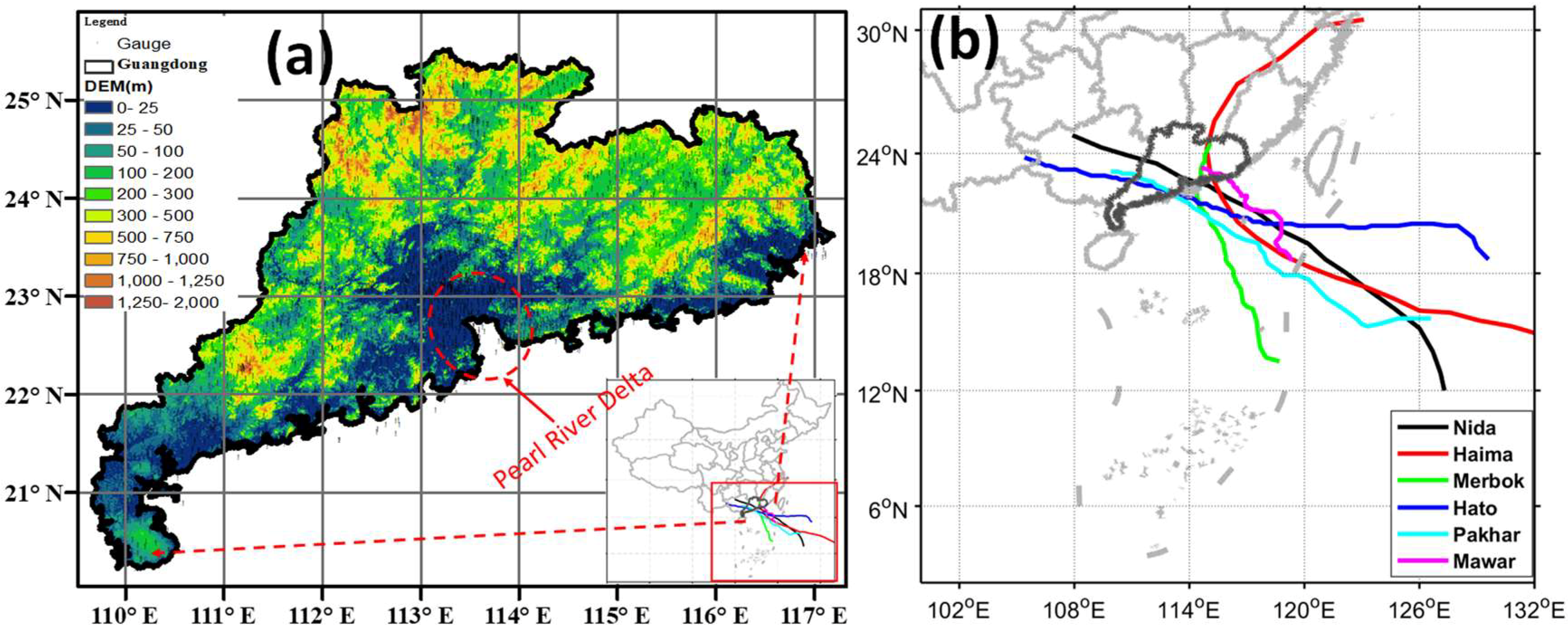
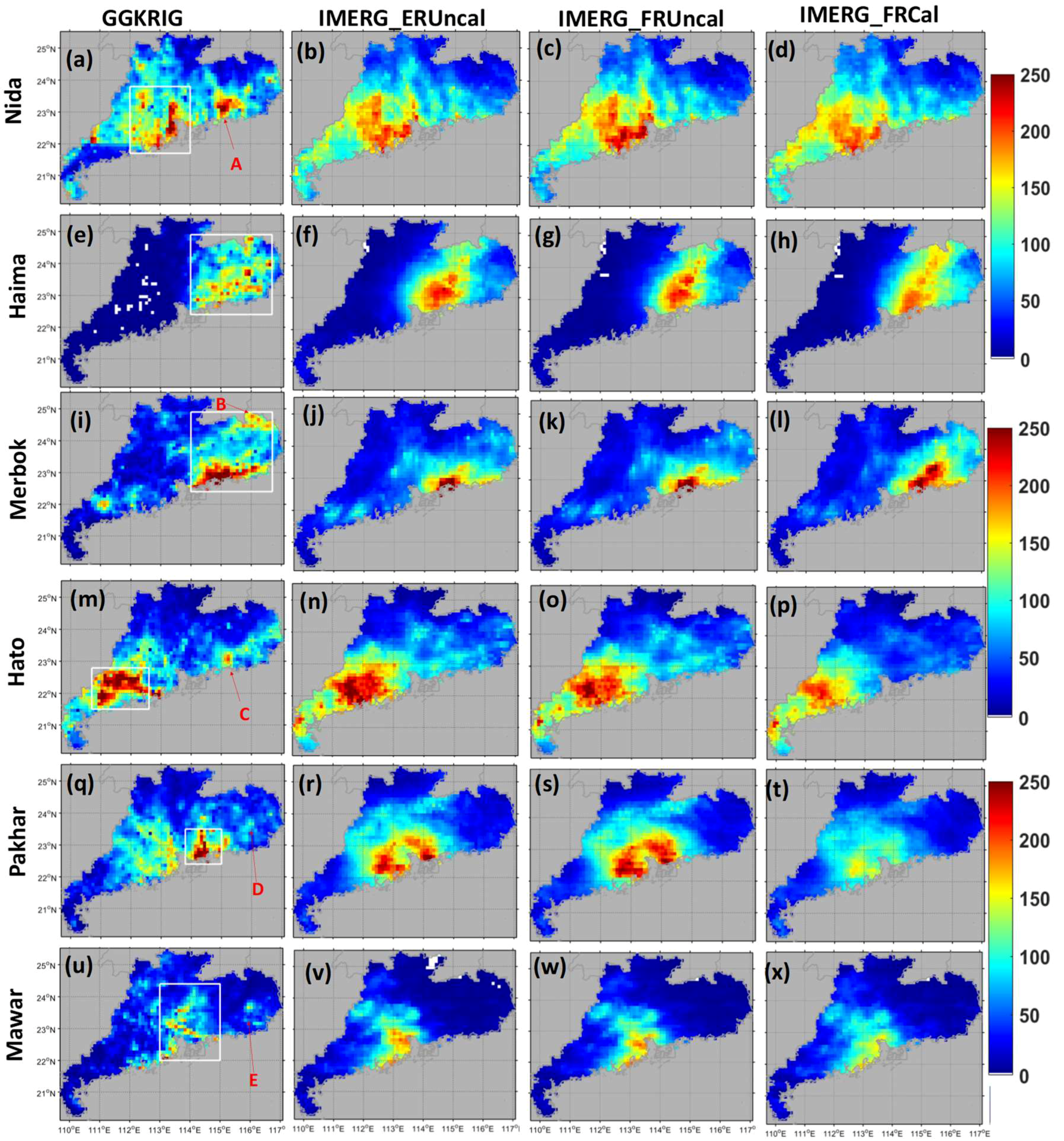
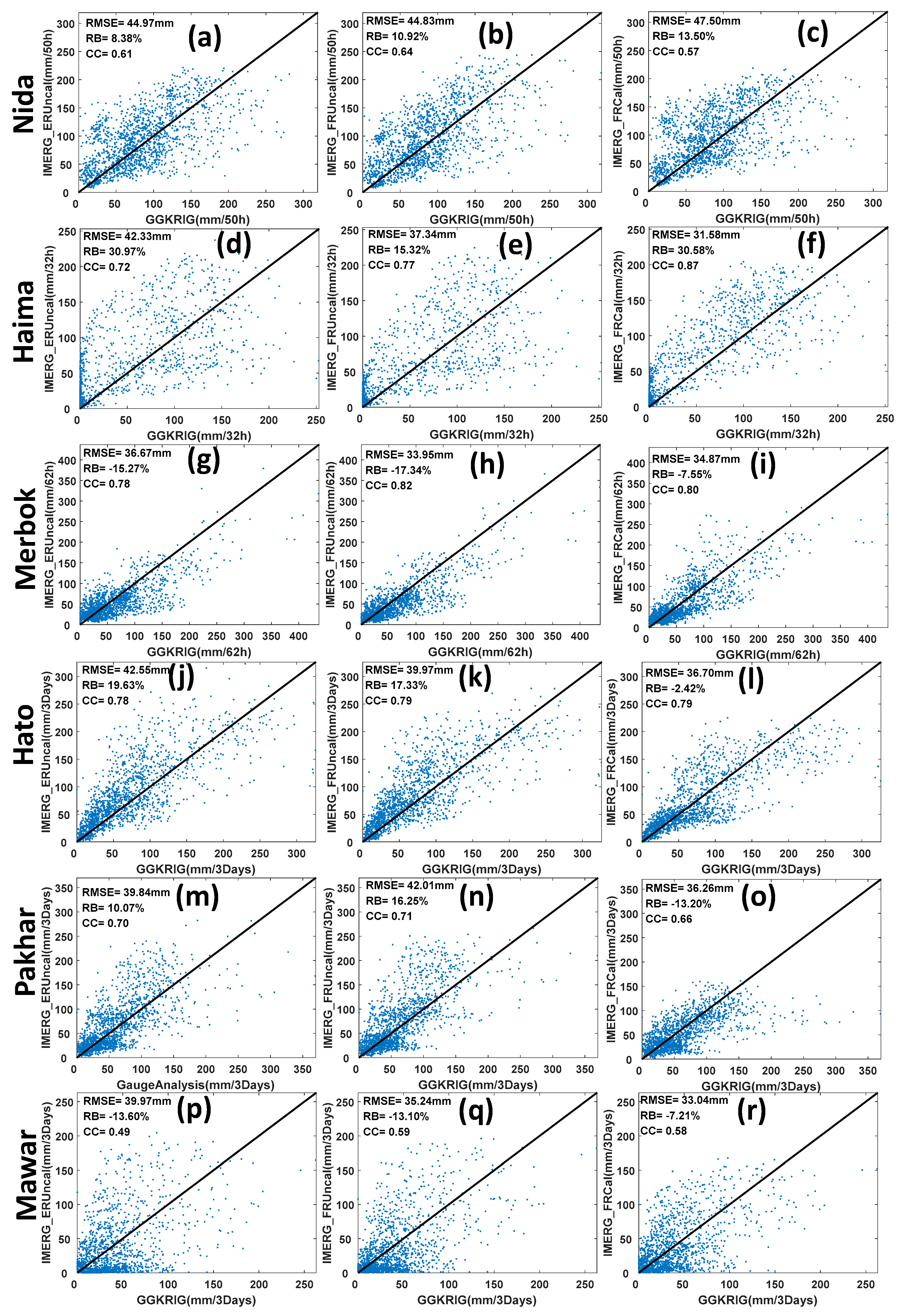
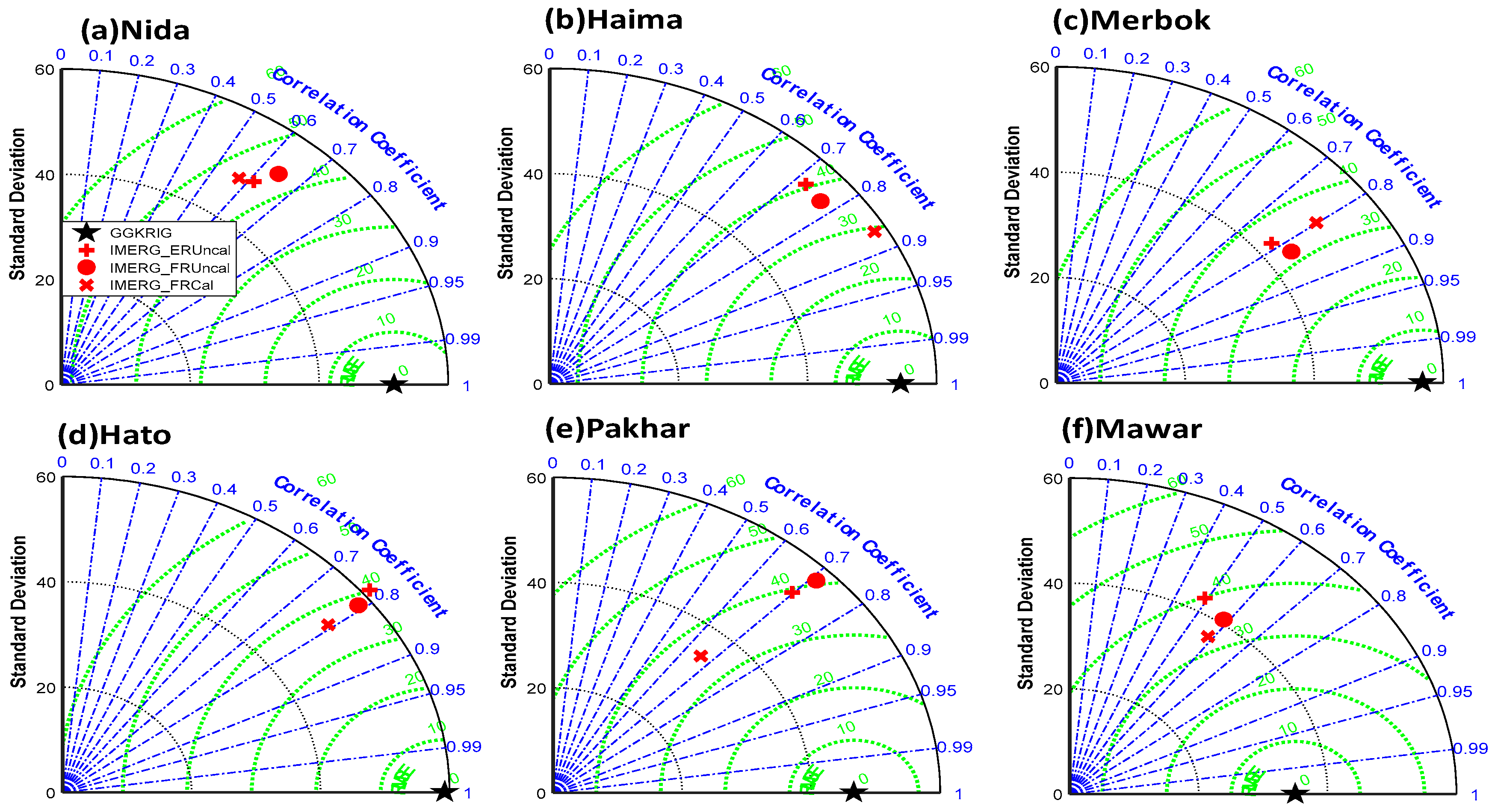
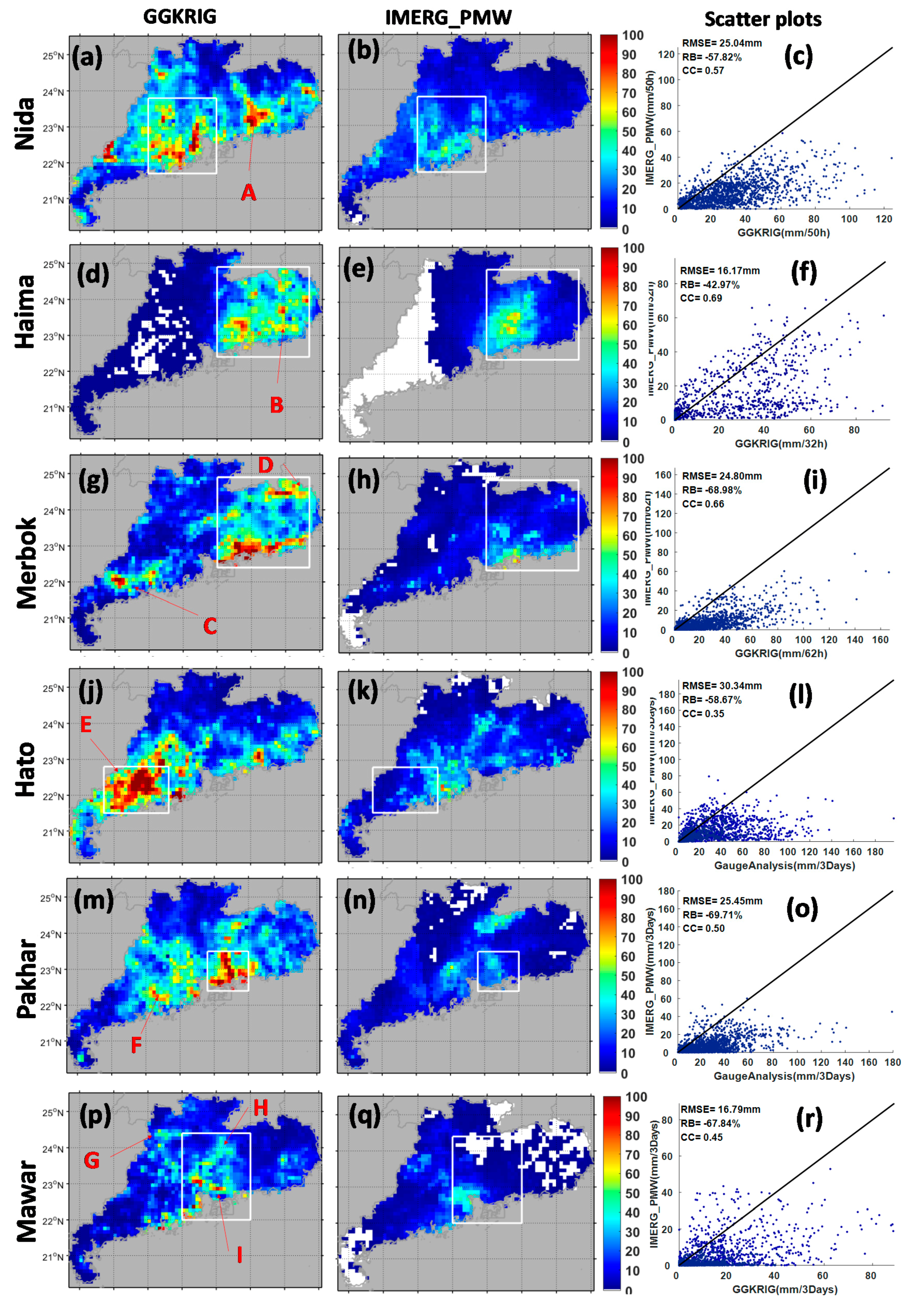


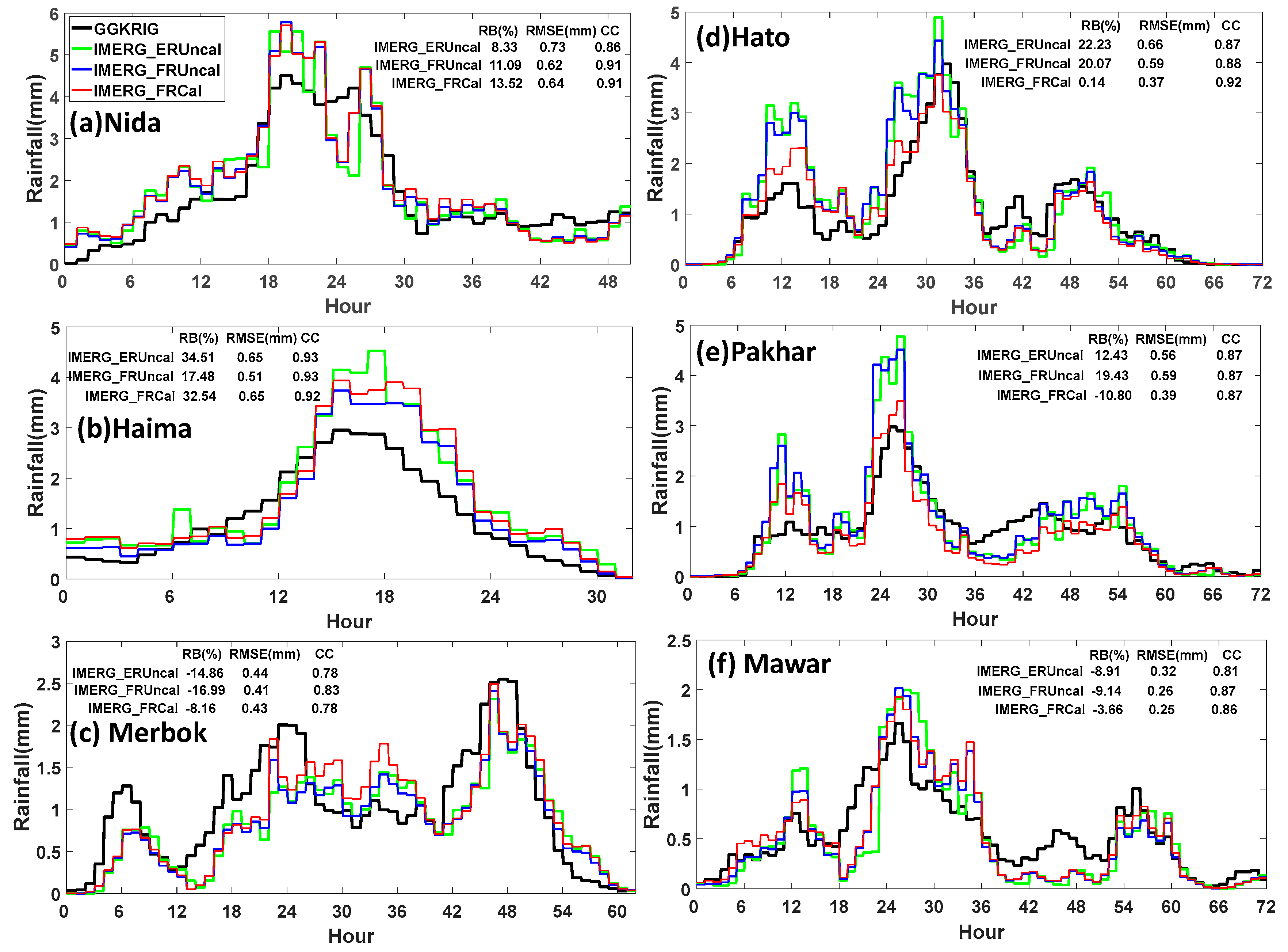
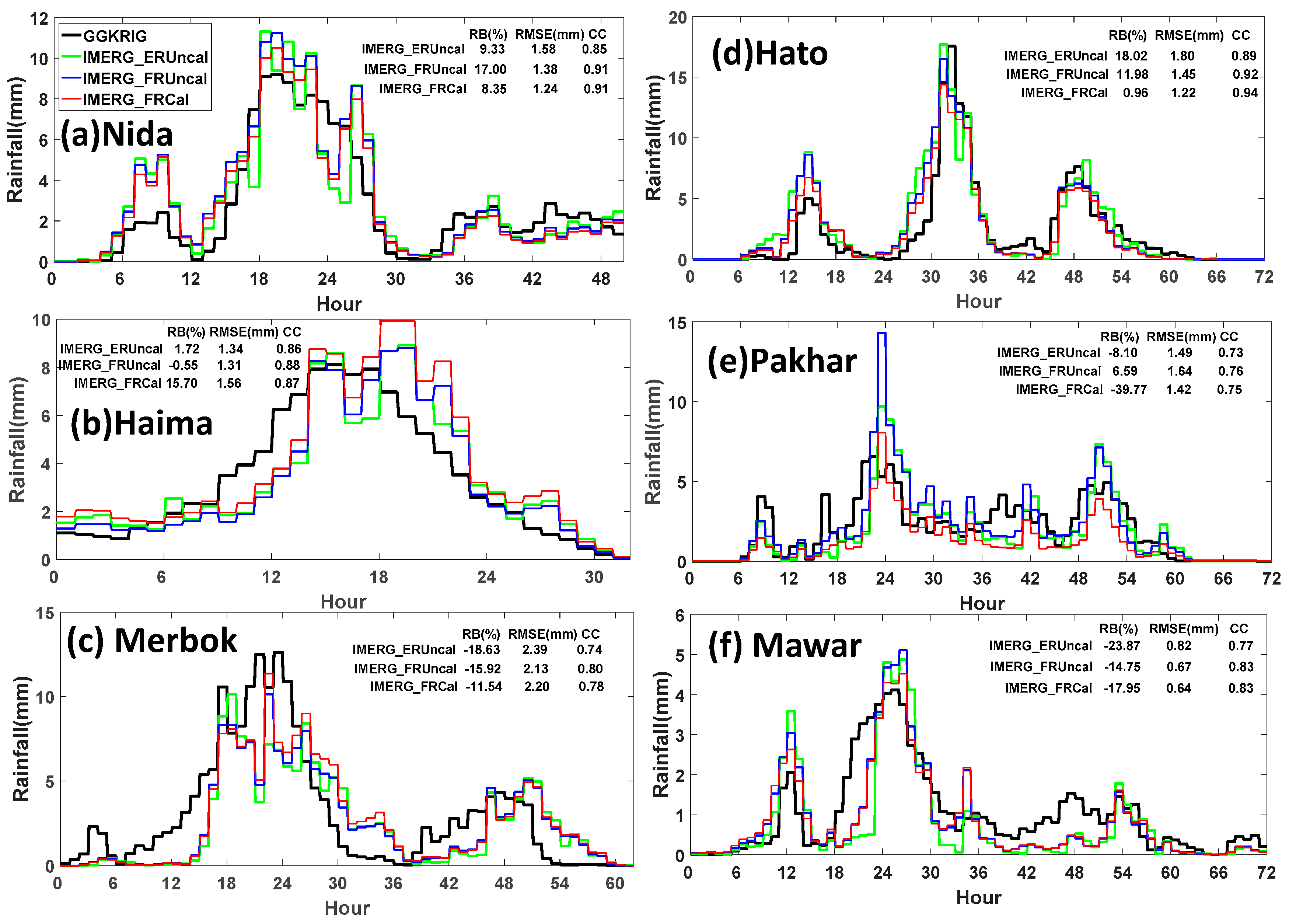

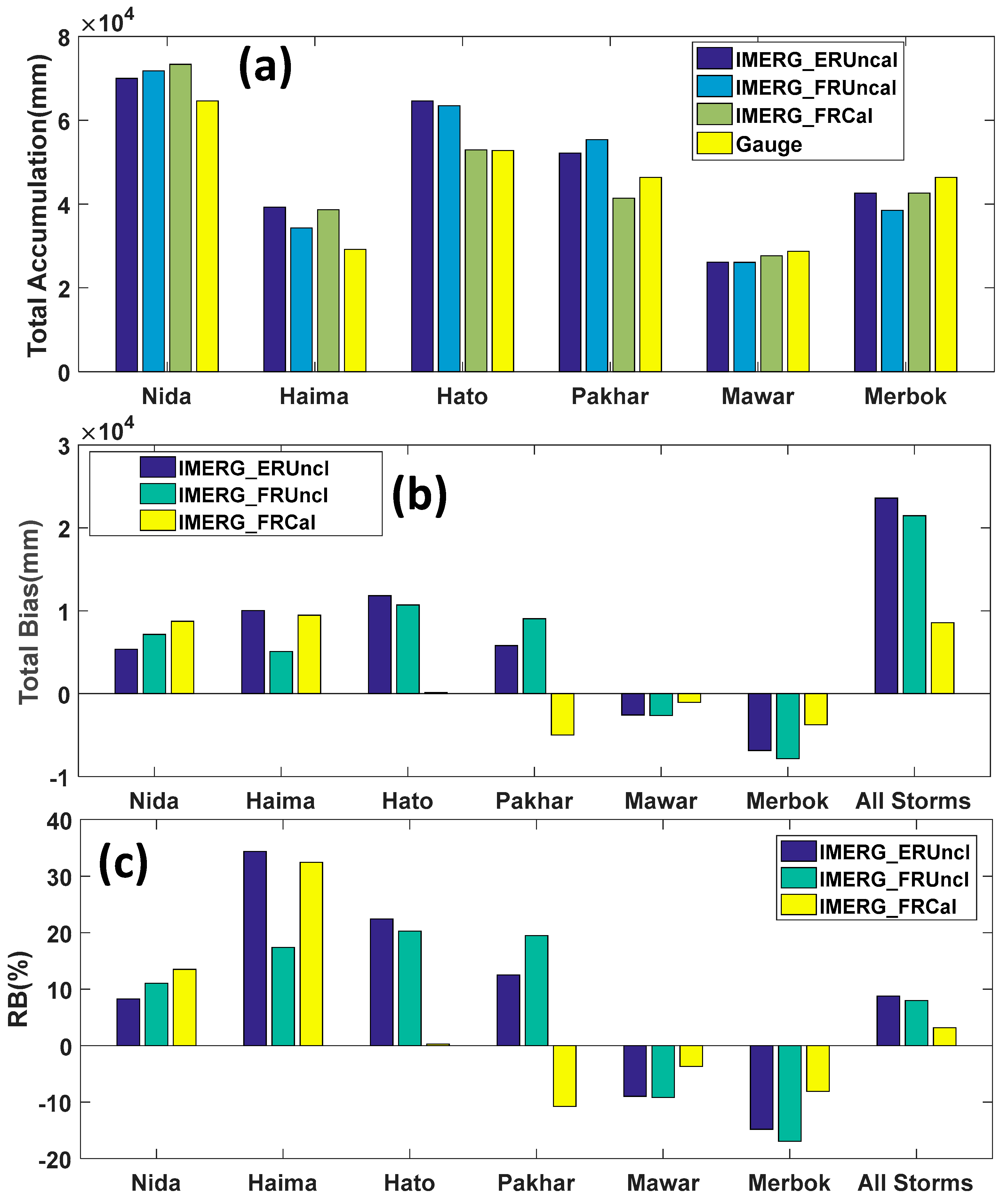
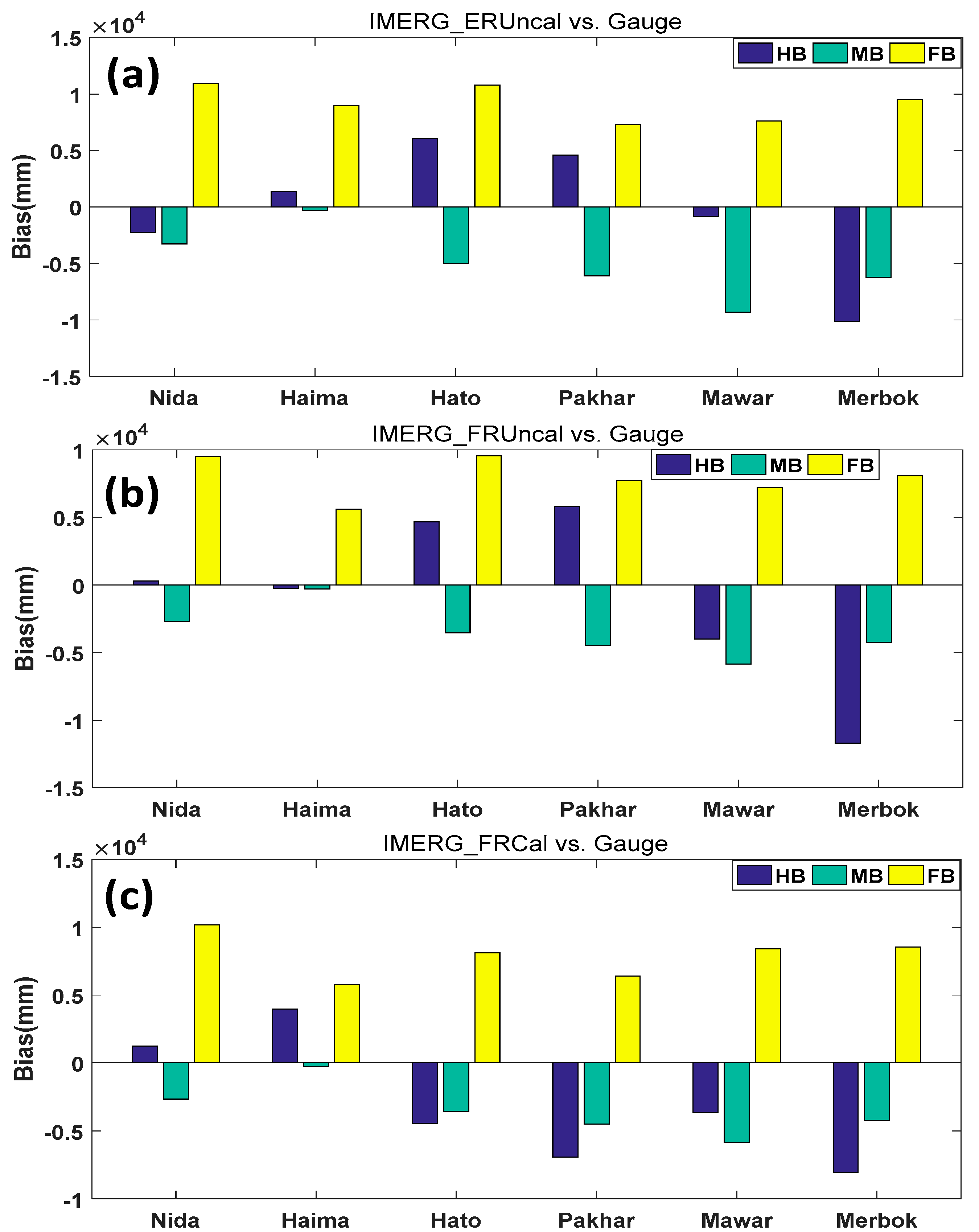
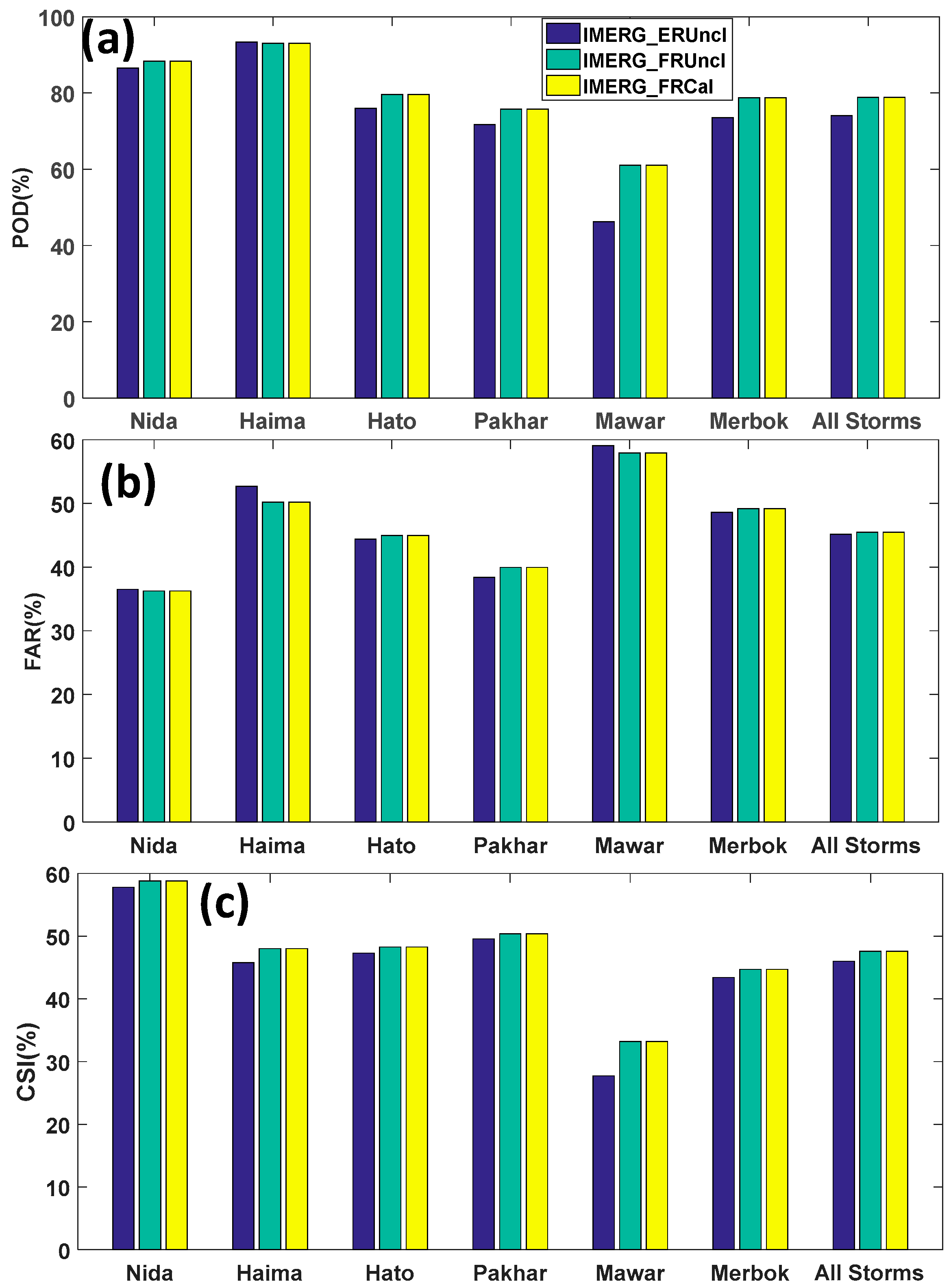


| No. | Typhoon Name | Start Time (UTC) | End Time (UTC) | Total Duration (h) | Max Accumulated Gauged Rainfall (mm) | Max Gauged Rain Rate (mm/h) |
|---|---|---|---|---|---|---|
| 1 | Nida | 2016-08-01 04:00 | 2016-08-03 06:00 | 50 | 333.8 | 106.9 |
| 2 | Haima | 2016-10-20 16:00 | 2016-10-21 23:00 | 32 | 244.5 | 76.5 |
| 3 | Merbok | 2017-06-12 00:00 | 2017-06-14 14:00 | 62 | 361 | 103.6 |
| 4 | Hato | 2017-08-22 00:00 | 2017-08-25 00:00 | 72 | 391.3 | 126.3 |
| 5 | Pakhar | 2017-08-26 00:00 | 2017-08-29 00:00 | 72 | 417.3 | 151.3 |
| 6 | Mawar | 2017-09-03 00:00 | 2017-09-06 00:00 | 72 | 284 | 97.6 |
| Gauge ≥ Threshold | Gauge < Threshold | |
|---|---|---|
| Satellite ≥ Threshold | Hits(H) | False alarms (F) |
| Satellite < Threshold | Misses(M) | Correct negative (C) |
| Metrics | Equations | Perfect Value |
|---|---|---|
| CC | 1 | |
| Bias | 0 | |
| RB (%) | 0 | |
| HB | 0 | |
| MB | 0 | |
| FB | 0 | |
| POD | 1 | |
| CSI | 1 | |
| FAR | 0 | |
| SDD | 0 | |
| RSD | 0 | |
| AI | 1 |
© 2019 by the authors. Licensee MDPI, Basel, Switzerland. This article is an open access article distributed under the terms and conditions of the Creative Commons Attribution (CC BY) license (http://creativecommons.org/licenses/by/4.0/).
Share and Cite
Huang, C.; Hu, J.; Chen, S.; Zhang, A.; Liang, Z.; Tong, X.; Xiao, L.; Min, C.; Zhang, Z. How Well Can IMERG Products Capture Typhoon Extreme Precipitation Events over Southern China? Remote Sens. 2019, 11, 70. https://doi.org/10.3390/rs11010070
Huang C, Hu J, Chen S, Zhang A, Liang Z, Tong X, Xiao L, Min C, Zhang Z. How Well Can IMERG Products Capture Typhoon Extreme Precipitation Events over Southern China? Remote Sensing. 2019; 11(1):70. https://doi.org/10.3390/rs11010070
Chicago/Turabian StyleHuang, Chaoying, Junjun Hu, Sheng Chen, Asi Zhang, Zhenqing Liang, Xinhua Tong, Liusi Xiao, Chao Min, and Zengxin Zhang. 2019. "How Well Can IMERG Products Capture Typhoon Extreme Precipitation Events over Southern China?" Remote Sensing 11, no. 1: 70. https://doi.org/10.3390/rs11010070
APA StyleHuang, C., Hu, J., Chen, S., Zhang, A., Liang, Z., Tong, X., Xiao, L., Min, C., & Zhang, Z. (2019). How Well Can IMERG Products Capture Typhoon Extreme Precipitation Events over Southern China? Remote Sensing, 11(1), 70. https://doi.org/10.3390/rs11010070






